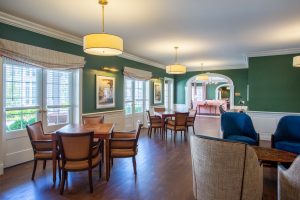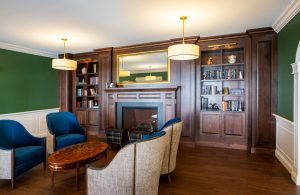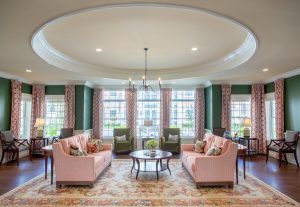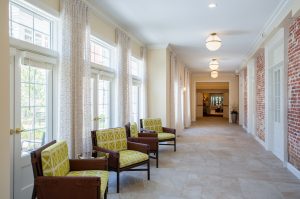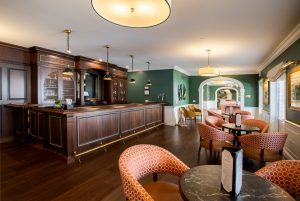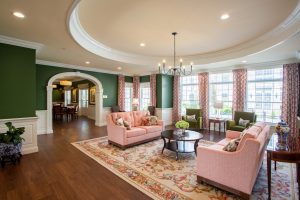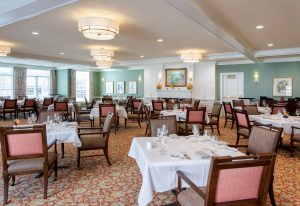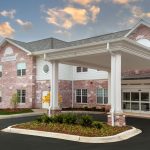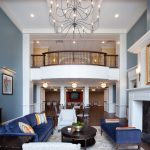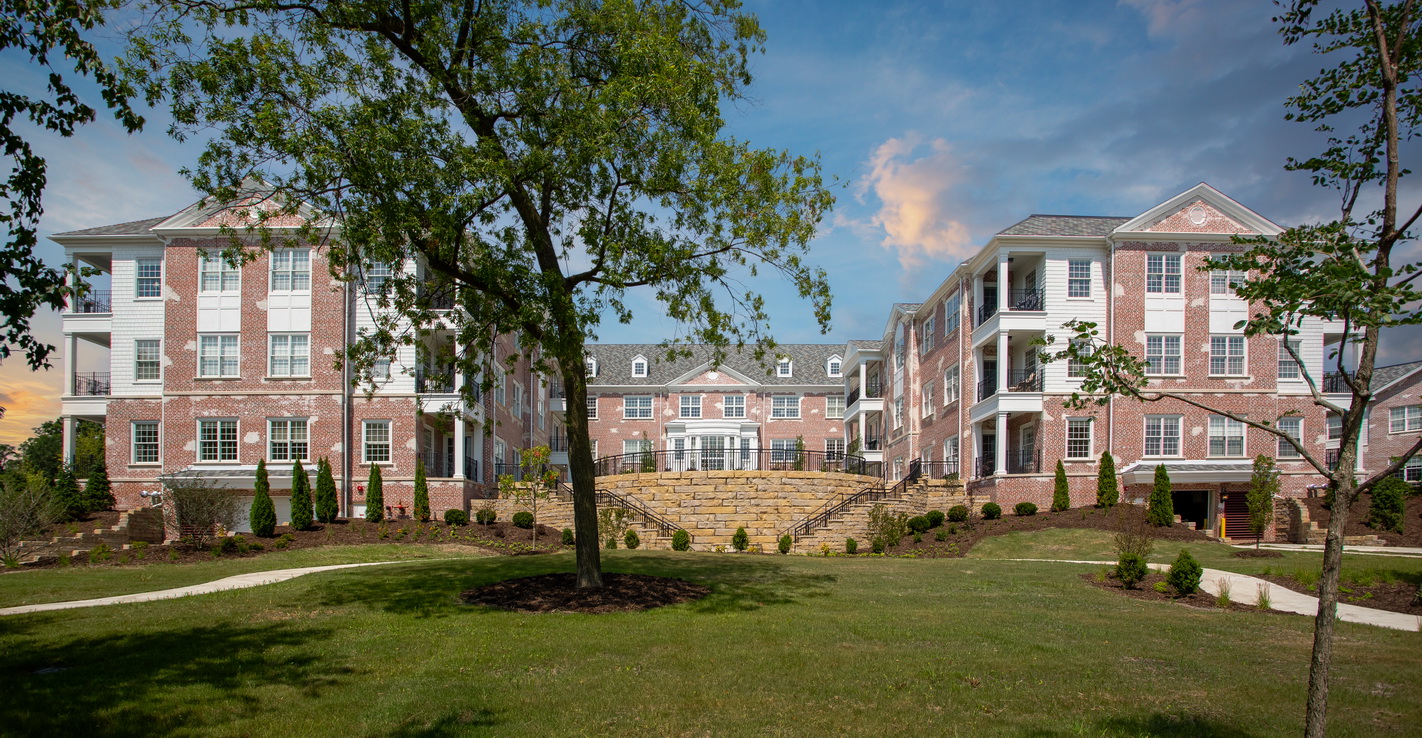
Initial Expectations
Inspired by the timeless elegance of 19th-century Georgian architecture, the design concept for the Independent Living (IL) building at King Bruwaert House, developed by SAS Architects & Planners, bridges historical influence with forward-looking functionality. Our vision aimed to honor both the legacy of the existing campus and the continuity of its architectural heritage. Key elements such as brick and German Schmere finishes, integration of the building within a garden-like setting, refined interior millwork, bold design accents, expansive exterior views, and generous public spaces shaped the foundational design principles.
Collaborative Coordination
From the earliest stages, the planning and design of both the Independent Living (IL) and Health Center (HC) components were deeply collaborative. For the Health Center, initial workshops involved nursing staff and physical/occupational therapy teams to address both resident and staff needs. Staff satisfaction—particularly among nurses, a known factor in retention—was given special attention to ensure the facility would support operational effectiveness and long-term engagement.
The Independent Living design process was improved by active engagement between SAS, the King Bruwaert House marketing and executive teams, and both current and prospective residents. These discussions provided valuable insights into preferred amenities, architectural styles, and unit configurations.
This inclusive approach, paired with ongoing coordination among project stakeholders, drove the design forward and laid the groundwork for a facility that all parties were eager to bring to life.
This input along with project team discussions and plan reviews pushed the design towards construction, and a facility all were excited to get started and see.
Adaptation to Delays
The onset of the COVID-19 pandemic introduced unexpected delays and significantly impacted both the project timeline and budget. As construction neared commencement, King Bruwaert House and its staff rightfully shifted focus to the immediate and evolving needs of their residents, adopting a preservation-first approach.
This delay provided an opportunity to reevaluate and enhance the Health Center’s design through a sharpened public health lens. Updates included the incorporation of an isolated visitor room, expanded terrace areas, improved exterior views, and a more efficient interior flow. The revised plan also called for the demolition of a substantial portion of the existing HC wing, which allowed for a redesigned footprint that better aligned with the site’s layout and improved access to the new main entrance and porte cochere.
Simultaneously, the outdoor environment between the IL and HC buildings was reimagined to strengthen the garden atmosphere, introduce additional greenery, and increase visual and physical privacy between resident bedrooms—all while maintaining a serene campus aesthetic.
The Buildings
In successfully executing the design, we faced the challenge of not only addressing the expectations of the residents, staff, and client team, but also integrating the design with the character of the existing building itself. Completed in 1933, the original structure boasts an extensive array of wood detailing, both painted and stained, along with rich wallpaper, carpet finishes featuring floral patterns, and an overall sense of symmetry. Georgian style architectural elements, such as multi-pane windows, millwork-trimmed openings, and stone and brick facades, contribute to the building’s timeless beauty and architectural integrity.
The addition to the Health Center presented its own unique set of challenges. The original Health Center addition, constructed in 1988, deviated significantly from the original building’s aesthetic. While it incorporated a similar brick color and white windows, the geometry was notably unconventional, and many of the signature design details were not carried over.
In designing the new Health Center addition, due to the site we could not fully replicate the original building’s symmetrical form. However, we were committed to honoring the legacy of the original structure. To that end, we introduced key design elements that mirrored the original, including a more refined approach to the detailing, window proportions, and the overall materiality of the façade. This allowed the new addition to integrate more cohesively with the historic building while still meeting the functional requirements of a modern healthcare facility.
Exterior Design
The exterior design carefully integrates elements evoking Georgian architectural style of the original facility. The coordination of door and window openings with surrounding trim, pilasters, and crossheads references the classic proportions of the original structure. Modern windows with transoms and simulated divided lights replicate the public window designs of the original building, while decorative eaves, louvered vents, and brick coursing unify the details across the façade.
The existing building’s original white plaster coating has weathered over time, revealing the underlying reddish brick. To maintain the historic character while incorporating modern materials, we collaborated with the International Masonry Institute (IMI) to apply a “German Schmere” plastering technique over the new masonry. This technique mimics the natural aging patterns found around existing windows, rooflines, and doorways, seamlessly blending the new addition with the existing structure. The symmetrical façades facing the exterior grand staircase, the sitting area, and the courtyard reinforce the Georgian aesthetic of the Independent Living addition.
Site Design
Respecting the site’s natural topography was a key consideration in the overall design. Given the hilly terrain, we strategically placed the parking garage beneath the building’s footprint, ensuring minimal disruption to the landscape and preserving the site’s visual integrity.
A grand staircase, symmetrically aligned with the interior two-story space and the original building, creates a strong visual axis that extends through the entrance and smaller courtyard, connecting both the old and new structures. This axis incorporates the new public interior spaces, with windows aligned to create a sense of continuity, and further extends toward the southern lawn and bocce court, terminating at the base of the grand stairs and descending the southern hill of the site.
In addition, new sidewalks were incorporated to connect all buildings, and extensive landscaping was designed to enhance the “building within a garden” experience, reinforcing the serene, garden-like environment central to the design philosophy.
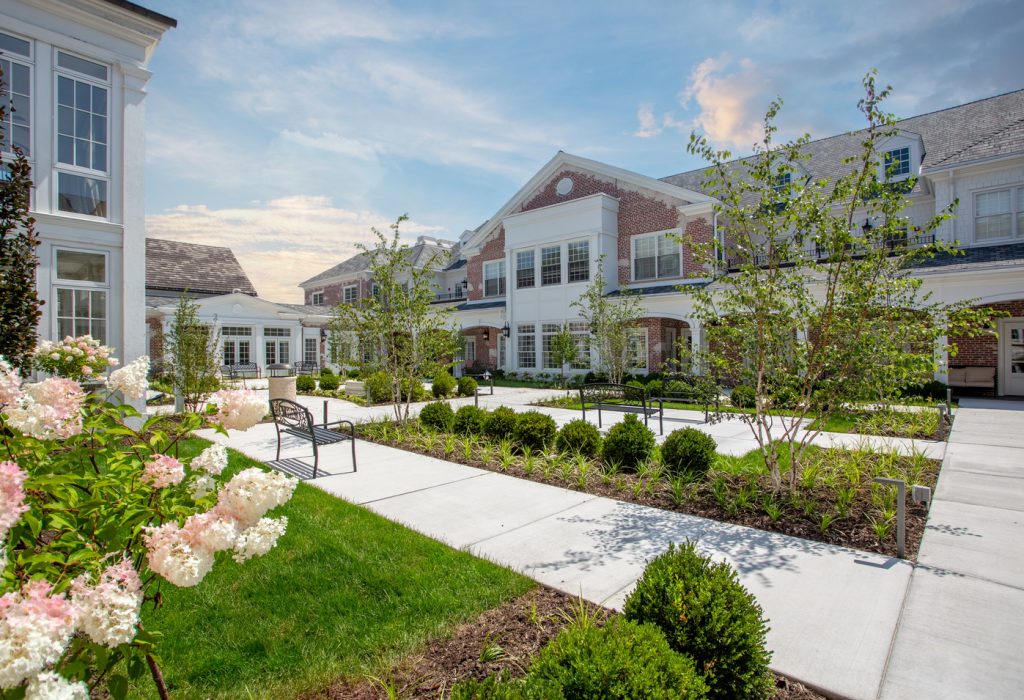
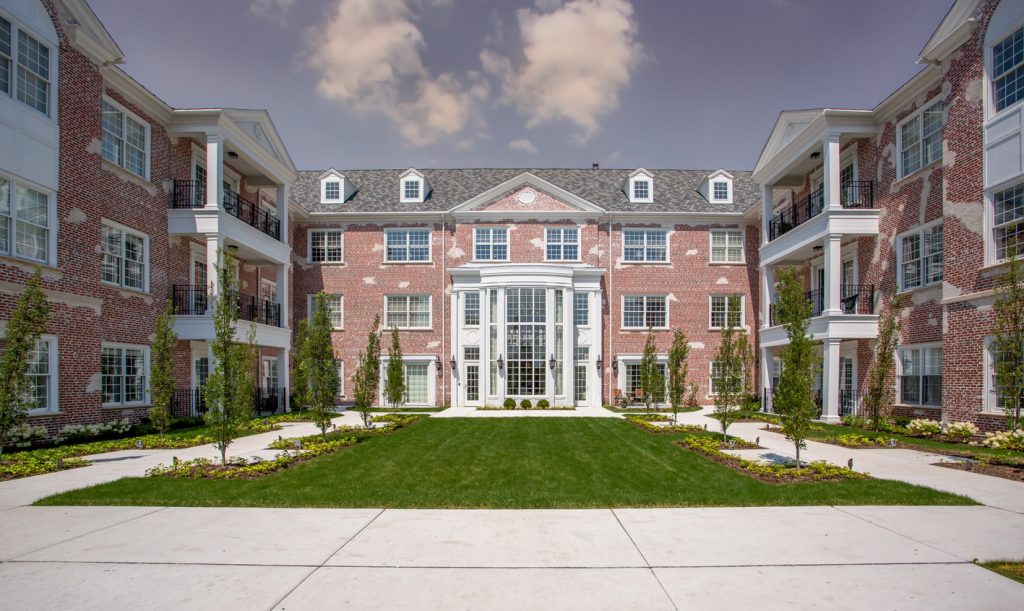
Interior Design
In the design of the Independent Living (IL) building, we sought to create a harmonious blend of the original architectural features with the contemporary updates of the new space. Key design elements, such as the replication of the wainscoting, the signature “KB Arch” from the King Bruwaert House logo, and elegant fireplaces, help establish a visual connection between the old and the new.
To balance tradition with modernity, we chose bold carpeting featuring floral patterns paired with wood flooring, creating a dynamic interplay of textures and colors. Faux coffered ceilings in the Dining Room and Great Room echo the intricate woodwork found in the original facility, reinforcing the historical design language. Strategic use of bold decorative lighting, while contemporary in style, was carefully selected to complement the original finishes and to create focal points without overwhelming the overall aesthetic.
Functionally, we ensured a seamless connection between the original and the new. A new display kitchen and back-of-house area were integrated directly with the existing kitchen, facilitating the efficient transfer of equipment, products, and cooking materials between the two spaces. This layout optimizes operations and enhances the functionality of the facility.
A key element that unifies the public spaces is the addition of a new Loggia, which offers views into the interior courtyard. With its high ceilings and complementary windows, this space leans against the original exposed brick of the existing building, further bridging the gap between the historic and contemporary elements of the design. The Loggia serves not only as a visual focal point but as a functional connector between the old and new portions of the building.
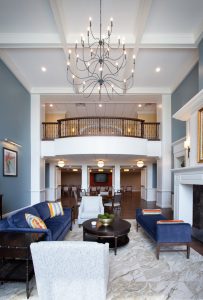
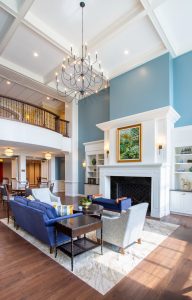
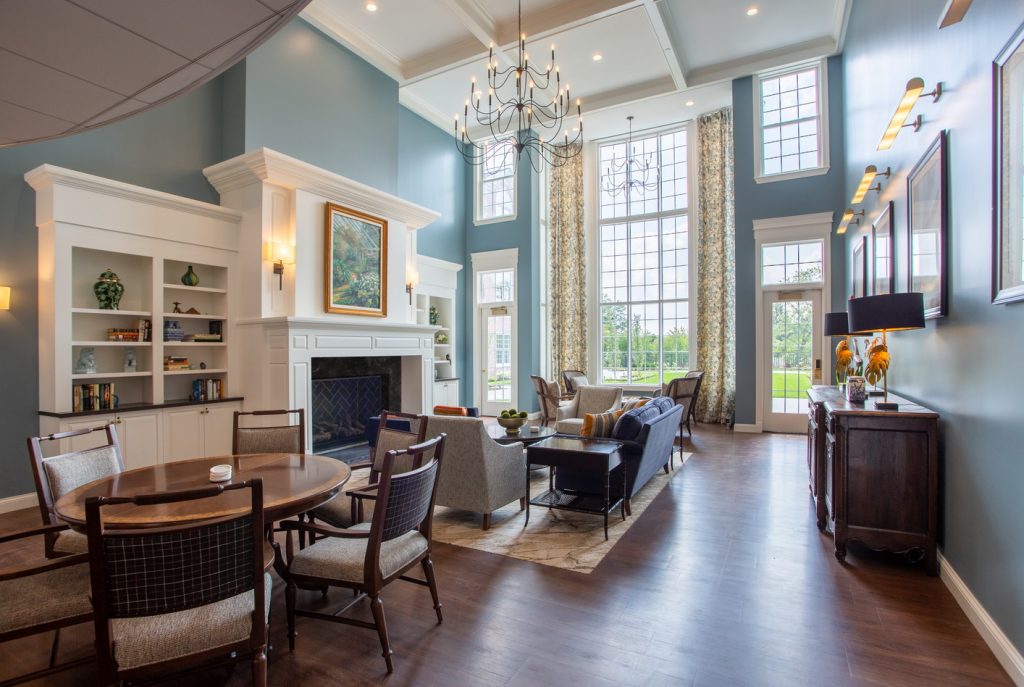
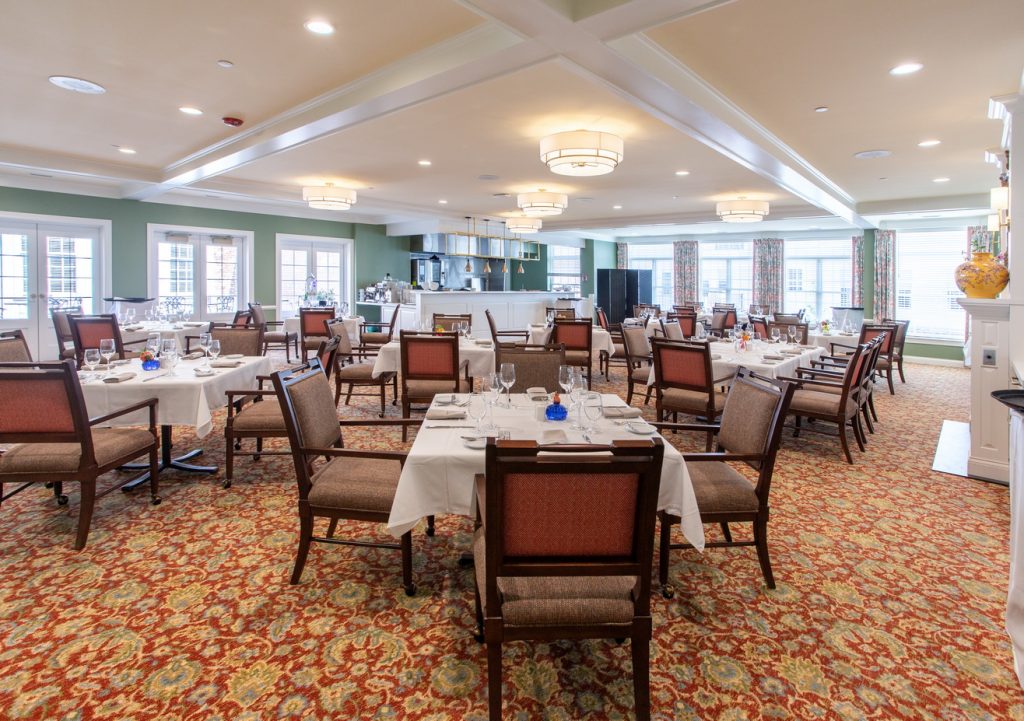
Execution
The execution of the project required careful consideration, as it involved a substantial portion of the existing property and two significant building footprints. This presented unique challenges for all stakeholders, particularly given King Bruwaert House’s close-knit community and the proximity of adjacent townhomes to the construction site. Ensuring minimal disruption to residents and maintaining a harmonious environment throughout the construction process were key priorities.
Once the contractor was fully on board, a comprehensive plan was developed to address logistical concerns, including noise management, visibility of the job site, material storage, construction traffic, parking, and the mitigation of dust and debris. These factors were thoroughly evaluated to ensure that both the residents’ well-being and the project’s efficiency were safeguarded.
Initially, the project called for a single mobilization that would see both the 115,000 square-foot Independent Living (IL) building and the 27,000 square-foot Health Center (HC) addition constructed simultaneously. However, due to unforeseen challenges within the construction industry—including rising costs and supply chain disruptions—the project was reorganized into two phased construction schedules. This shift allowed the team to better manage the scope and timeline.
The construction sequence began with the Health Center addition, followed by the interior renovation of the original Health Center building. The Independent Living facility was slated to begin after these phases, but in practice, the foundation work for the IL building commenced as the HC addition neared completion and the renovation work was underway.
This adjusted schedule alleviated the challenge of having the entire site under construction at once, helping to preserve green space and minimize construction-related traffic near the existing residential areas. By staggering the construction phases, the project team was able to reduce the overall material demand at any given time, easing the effects of supply chain delays. Additionally, the experienced team at Pepper Construction expertly coordinated site logistics and planning, ensuring that all aspects of the project proceeded smoothly and efficiently despite the external challenges.
Ribbons Are Cut
The project commenced with design planning in 2018, followed by groundbreaking in 2021. The Health Center (HC) officially opened its doors in August 2023, and substantial completion of the Independent Living (IL) addition occurred in March 2024, marking the full realization of the vision for all at King Bruwaert House.
These new additions not only honor the architectural legacy of the original building but also thoughtfully address the evolving needs of the King Bruwaert House community. The introduction of the new Independent Living concept, previously not present on campus, offers a modern, state-of-the-art living environment designed to serve as a comfortable and enduring home for many residents for years to come.

